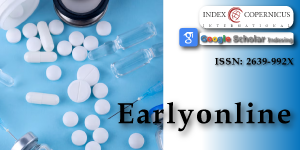Green Synthesis of Citrus sinensis Peel (Orange Peel) Extract Silver Nanoparticle and its Various Pharmacological Activities
Main Article Content
Abstract
Citrus sinensis is a rich source of bioactive compounds and has attracted attention due to its medicinal benefits. Historically regarded as agricultural waste, orange peel is rich in flavonoids, polyphenols, tannins, and essential oils with antibacterial, anti-inflammatory, and antioxidant qualities. The phytochemicals in Citrus sinensis peel were used as natural reducing and stabilizing agents in the green synthesis method used in this work to create silver nanoparticles (AgNPs). This method is an environmentally friendly alternative to conventional nanoparticle production, eliminating the need for hazardous chemicals. Based on the study’s results, green-synthesized silver nanoparticles derived from Citrus sinensis peel extract offer a sustainable and biocompatible substitute for biomedical applications. The pharmaceutical and healthcare industries may find therapeutic uses for them due to their exceptional antibacterial, antioxidant, and anticancer properties.
Article Details
Copyright (c) 2025 Bagyalakshmi J, et al.

This work is licensed under a Creative Commons Attribution 4.0 International License.
Bagyalakshmi J, Bavya C. Preparation, characterization, and pharmacokinetic interactions study of green synthesized silver nanoparticles of Pterocarpus marsupium with antidiabetic drug. Int J Res Pharma Pharm Sci. 2023;3(1):1-20.
Bagyalakshmi J, Navaneethkrishnan C, Priya K. Formulation and evaluation of soap film incorporated with green synthesized Azadirachta indica silver nanoparticles. Nanoparticle. 2024;5(1):13. Available from: https://www.jnanoparticle.com/full-text/formulation-and-evaluation-of-soapfilm-incorporated-with-green-synthesized-azadirachta-indica-silver-nanoparticles
Bagyalakshmi J, Sowmiyadevi B. Characterization and evaluation of green synthesized silver nanoparticles using Moringa oleifera leaf extract and its antihypertensive activity. Ann Clin Med Case Rep. 2024;13(16):1-9. Available from: https://acmcasereport.org/wp-content/uploads/2024/05/ACMCR-v13-2195.pdf
Kaviya S, Santhanalakshmi J, Viswanathan B, Muthumary J, Srinivasan K. Biosynthesis of silver nanoparticles using Citrus sinensis peel extract and its antibacterial activity. Spectrochim Acta A Mol Biomol Spectroscopy. 2011;79(3):594–8. Available from: https://doi.org/10.1016/j.saa.2011.03.040
Mojo T, Sutrisno, Marfuah S. Chemical content and pharmacology of sweet orange (Citrus sinensis) fruit peel: a review. E3S Web Conf. 2024;481:06002. Available from: https://doi.org/10.1051/e3sconf/202448106002
Gotmare S, Gade J. Orange Peel: A Potential Source of Phytochemical Compounds. Int J Chemtech Res. 2018;11(02):240-3. Available from: https://sphinxsai.com/2018/ch_vol11_no2/2/(240-243)V11N02CT.pdf
Abou Baker DH, Ibrahim BMM, Abdel-Latif Y, Hassan NS, Hassan EM, El Gengaihi S. Biochemical and pharmacological prospects of Citrus sinensis peel. Heliyon. 2022;8: e09979. Available from: https://doi.org/10.1016/j.heliyon.2022.e09979
Favela-Hernández JMJ, González-Santiago O, Ramírez-Cabrera MA, Esquivel-Ferriño PC, Camacho-Corona MR. Chemistry and Pharmacology of Citrus sinensis. Molecules. 2016;21(2):247. Available from: https://doi.org/10.3390/molecules21020247
Usharani S, Devi BR. Synthesis of silver nanoparticles using orange peel extracts and their antibacterial activity. World J Pharm Res. 2019;8(10):854-869. Available from: https://wjpr.s3.ap-south-1.amazonaws.com/article_issue/1567244676.pdf
Bagyalakshmi J, Priya BSK, Bavya C. Evaluation of antidiabetic activity of aqueous extract of bark of Pterocarpus marsupium silver nanoparticles against streptozotocin and nicotinamide induced type 2 diabetes in rats. Biomed J Sci Tech Res. 2022;43(1):34254-34268. Available from: https://biomedres.us/pdfs/BJSTR.MS.ID.006853.pdf
Liew SS, Ho WY, Yeap SK, Sharifudin SA. Phytochemical composition and in vitro antioxidant activities of Citrus sinensis peel extracts. PeerJ. 2018;6:e5331. Available from: https://doi.org/10.7717/peerj.5331
Sonawane N, Patil S, Patil C, Patil S, Chinchore R. Orange peel: A comprehensive review on residue properties. Int J Pharmacogn Pharm Sci. 2024;6(1):22-27. Available from: https://www.pharmacognosyjournal.net/archives/2024/vol6issue1/PartA/6-1-3-231.pdf
Ould Yerou K, Bouhadi D, Hariri A, Meddah B, Tir Touil A. The use of orange (Citrus sinensis) peel as antimicrobial and antioxidant agents. J Fundam Appl Sci. 2017;9(3):1351-1357. Available from: http://dx.doi.org/10.4314/jfas.v9i3.7
Anwar T, Qureshi H, Fatima A, Sattar K, Albasher G, Kamal A, et al. Citrus sinensis Peel Oil Extraction and Evaluation as an Antibacterial and Antifungal Agent. Microorganisms. 2023;11(7):1662. Available from: https://doi.org/10.3390/microorganisms11071662
Mogole L, Omwoyo W, Viljoen E, Moloto M. Green synthesis of silver nanoparticles using aqueous extract of Citrus sinensis peels and evaluation of their antibacterial efficacy. Green Process Synth. 2021;10(1):851-859. Available from: https://doi.org/10.1515/gps-2021-0061
Mickky B, Elsaka H, Abbas M, Gebreil A, Shams Eldeen R. Orange peel-mediated synthesis of silver nanoparticles with antioxidant and antitumor activities. BMC Biotechnol. 2024;24:66. Available from: https://doi.org/10.1186/s12896-024-00892-z
Castañeda-Aude JE, Morones-Ramírez JR, De Haro-Del Río DA, León-Buitimea A, Barriga-Castro ED, Escárcega-González CE. Ultra-Small Silver Nanoparticles: A Sustainable Green Synthesis Approach for Antibacterial Activity. Antibiotics (Basel). 2023;12(3):574. Available from: https://doi.org/10.3390/antibiotics12030574
Arooj N, Dar N, Samra ZQ. Stable Silver Nanoparticles Synthesis by Citrus sinensis (Orange) and Assessing Activity Against Food Poisoning Microbes. Biomed Environ Sci. 2014;27(10):815-818. Available from: https://doi.org/10.3967/bes2014.118
Niluxsshun MCD, Masilamani K, Mathiventhan U. Green Synthesis of Silver Nanoparticles from the Extracts of Fruit Peel of Citrus tangerina, Citrus sinensis, and Citrus limon for Antibacterial Activities. Bioinorg Chem Appl. 2021;2021:6695734. Available from: https://doi.org/10.1155/2021/6695734
Khabeeri OM, Al-Thabaiti SA, Khan Z. Citrus sinensis Peel Waste Assisted Synthesis of AgNPs: Effect of Surfactant on the Nucleation and Morphology. SN Appl Sci. 2020;2:2038. Available from: https://link.springer.com/article/10.1007/s42452-020-03801-z
Castro L, Blázquez ML, González F, Muñoz JA, Ballester A. Biosynthesis of silver and platinum nanoparticles using orange peel extract: characterization and applications. IET Nanobiotechnol. 2015;9(5):252–258. Available from: https://doi.org/10.1049/iet-nbt.2014.0063
Mostafa YS, Alamri SA, Alrumman SA, Hashem M, Baka ZA. Green synthesis of silver nanoparticles using pomegranate and orange peel extracts and their antifungal activity against Alternaria solani, the causal agent of early blight disease of tomato. Plants. 2021;10(11):2363. Available from: https://doi.org/10.3390/plants10112363
Bagyalakshmi J, Sivakumaran SS, Priya K, Swathika R. Green synthesis and characterization of silver nanoparticles using Cassia fistula and assessment of its in vitro anti-diabetic activity. Glob J Allergy. 2023;9(1):001-011. Available from: https://doi.org/10.17352/2455-8141.000026





